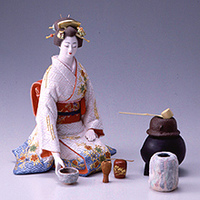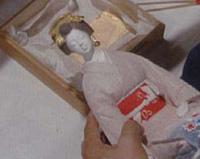

Total:131items
- Pottery & Porcelain (18)
- Lacquerware (4)
- Glasswork (2)
- Wood & Bamboo Work (19)
- Leather Work (1)
- Papermaking (13)
- Textile (20)
- Dyeing products (5)
- Masonry (1)
- Metal Work (11)
- Stationery (4)
- Livingware (3)
- Accessory (4)
- Toys & Entertainment (14)
- Hyuga Goishi: Huga Go Stones
- Kurashiki Hariko: Kurashiki Papier-mache
- Kishu Bina : Kishu Dolls
- Hakata Ningyo: Hakata Doll
- Kaga-mizuhiki: Kaga Paper Cord Ornament
- Kasukabe Oshie Hagoita: Kasukabe's battledore with a padded cloth picture
- Iwatsuki Ningyo: Iwatsuki Doll
- Tsugaru Tako: Tsugaru Kite
- Jindai-Goma: Jindai Spinning Top
- Suruga Hina Dolls
- Knohazaru: Konohazaru Dolls
- Mishima Oni Yōzu kite (Mishima Demon Kite)
- Gunma Kokeshi Doll
- Koga Ningyo: Koga Clay Doll
- Interior (2)
- Other crafts (10)

 |
Main Production Site:Fukuoka |
 《Characteristics》
《Characteristics》Hakata Dolls can be broadly categorized into; Bijin-mono (dolls of beautiful ladies), Kabuki-mono (dolls inspired by Kabuki; Highly-stylized traditional Japanese play with singing and dancing), Noh-mono (dolls inspired by Noh; Traditional Japanese drama with simplified setting and performance style), Fuuzoku-mono (dolls depict daily customs), Dooshyaku-mono (dolls allegorize Taoism and Buddhism), Warabe-mono (dolls of children), Sekku-mono (dolls depict seasonal festivals). Such an abundant variety of subject matters of Hakata Dolls are based on daily continuous study in the search of unique elegance in creation representing different scenes of life. In addition, the proactive attitude toward artistry learnt from Western paintings, Japanese paintings, sculptures and so on have great influence on the characteristics of Hakata Dolls. Hakata Dolls have specialty and uniqueness in their calm aesthetic feeling produced by painting on unglazed figures, delicate carving and other features.
[Traditional Craft Officially Designated by Minister of Economy, Trade and Industry]
Articles by : Association of Hakata Dolls Trade and Production

| Materials | White clay |
|---|---|
| Crafting Processes | [1] Kneading
Carefully knead clay dug from suburban area of Fukuoka, after drying, grinding and levigating process. [2] Making original mold Produce the original mold based upon artistic plan and sketch developed by the creator. Carve clay into figure head, body, hands, feet and others. [3] Molding Mold the figure from the original with plaster. Several or tens of molds are made for each parts of the original mold when the shape of figure is complicated. [4] Making a base figure Pack well-kneaded-clay to the plaster mold made from the original so that the clay properly sticks to it. [5] Firing Dolls used to be fired in the kiln called "Karataki-Gama" (literally, a no-water kiln) with pine wood in the old days. Nowadays, most of them are fired in the electric or gas kiln. [6] Painting After taken out of the kiln, the figure's skin part is painted with whiting and other pigments. Then the patterns of kimono and other parts such as "Obi", a sash for kimono, are carefully painted. [7] Face Painting Paint doll's face part using "Menso-fude", a brush for applying make-up. Lips, eyes, eyebrows and others are painted. [8] Completion |
| History | Traditionally, Hakata, the northwestern part of current Fukuoka-city, Fukuoka prefecture, has been under influence of the East Asian Culture. We can see such influence in famous craft works such as Hakata-ori (Hakata weaving) and Hakata Dolls. By the excavation, it was revealed that the custom to appreciate unglazed dolls originated from Chinatown in Hakata and temples/shrines in Kamakura about 800 years ago in Kamakura period (12-14c).
It is told that in the year of 1600 (in Azuchi-Momoyama period, 16-17c), due to the entry of Nagamasa Kuroda, one of then feudal lords, into the country of Chikuzen (currently a part of Fukuoka prefecture), many craftsmen were gathered and unglazed dolls have evolved among them which constructed the foundation of current traditional craft of Hakata dolls. By the active contribution of famous craftsmen in later Edo period (17-19c) such as Soshichi Masaki (his work is called "Soshichi Yaki"), Kichibei Nakanoko and Buhei Shirouzu, Hakata Dolls industry prospered and the dolls were distributed all over Japan. In Meiji period (19-20c), Hakata Dolls were highly appreciated at international expositions such as the one in Paris. Then "Hakata Dolls" became widely known as typical Japanese dolls and started to be exported abroad. Currently, nearly 100 craftsmen are producing the dolls with the technique inherited from the past. |
| Related URL | https://www.hakataningyo.or.jp/ |
◆Exhibition / Showcase
Various exhibitions and sale are held.
Refer to tourism information etc. for each exhibition as they are held at various places and time.
◆Event Information
Hakata Ningyo Kuyo (Memorial service of Hakata Dolls)
Date: Second Saturday of December every year
Place: Sho-sho-in Temple
Tel: +81-(0)92-431-3595 (Japanese only)
Address : 1-7-37, Hakata Ekimae, Hakata-ku, Fukuoka City, Fukuoka pref.
Assistance needed? For inquiries in English:
JTCO Contact Form
Your inquiries will be forwarded by JTCO in Japanese to the organization you wish to contact.



